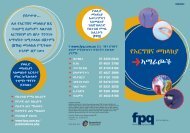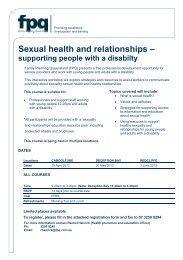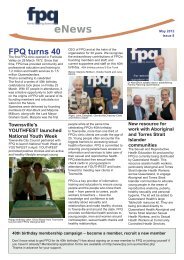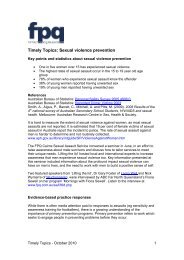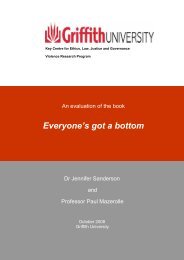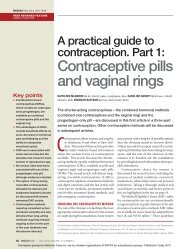Mirena®, The - Family Planning Queensland
Mirena®, The - Family Planning Queensland
Mirena®, The - Family Planning Queensland
You also want an ePaper? Increase the reach of your titles
YUMPU automatically turns print PDFs into web optimized ePapers that Google loves.
-CONTRACEPTION<strong>The</strong> progestogen-releasingintrauterine device – Mirena ®-Mirena ®in the uterusA Mirena ® intrauterine contraceptivedevice (IUD) is a small device which isfitted inside the uterus, where itreleases a hormone to preventpregnancy.What is Mirena ® ?Mirena ® is the brand name for the IUDwhich releases a progestogen (a hormonesimilar to the hormone progesteronewhich is naturally produced by the femalebody). It is T-shaped, made of plastic andcan prevent pregnancy for up to five yearsby steadily releasing small amounts of theprogestogen directly into the uterus.How does Mirena ® work?Once inside the uterus, Mirena ® preventspregnancy by:• thickening of the mucus of the cervix sothat sperm cannot enter the uterus• changing the lining of the uterus,making it unsuitable for pregnancy<strong>The</strong> device has fine threads attached tothe lower end of it so that when it is fitted,the threads protrude through the cervix(neck of the womb) into the vagina.<strong>The</strong>se threads allow the woman to checkthat the device is still in place and enableseasy removal of the device by a doctor.How effective is Mirena ® ?Mirena ® is approximately 99.9% effective.This means that on average, if 1,000women use Mirena ® for one year, it ispossible that one of them may becomepregnant.What are the advantages of Mirena ® asa method of contraception?• highly effective• long acting (effective for 5 years)• does not require daily pill taking orregular injections• reversible and rapid return to usualfertility• reduces amount of blood loss withperiods and in some women improvespainful periods• does not interfere with breastfeeding• inexpensiveFOR SEXUAL ANDREPRODUCTIVE HEALTH1
What are the disadvantages of Mirena ®as a method of contraception?• insertion and removal of the device canonly be performed by a trained doctor• insertion requires a procedure whichsome women may find quiteuncomfortable• bleeding patterns may become irregularand spotting and irregular light bleedingare common during the first 3-5 monthsafter insertion• does not protect against sexuallytransmitted infections (STIs)What are the possible health benefitsof Mirena ® ?• after about 5 months nearly all womenwill experience light periods only• after 12 months about 20% of womenwill have no periods at all• can be used to treat excessively heavymenstrual bleeding once serious causesfor heavy bleeding have beeninvestigated by a doctor• reduces period pain in many women• may be suitable for women approachingmenopause as it provides effectivecontraception and can continue to beused as the progestogen component ofhormone replacement therapyWhat are the possible side effects orcomplications of Mirena ® ?Side effects of the hormone in Mirena ®include:• changes in periods as above• only a very small amount of progestogenpasses into the bloodstream. This meansthat other side effects are fairly rare, mildand often improve with time. <strong>The</strong>yinclude acne, breast soreness, headacheand mood changes. Mirena ® should haveno effect on weight.Side effects and complications of theinsertion procedure can include:• following insertion, some women noticeabdominal cramping pain and bleedingfor up to a week or two• perforationThis is a rare but potentially seriouscomplication where the Mirena ® devicepasses through the wall of the uterusinto the pelvic area, usually at the timeof insertion but can very occasionallyoccur later. This can occur in about oneper 1,000 insertions. This requiressurgery under a general anaesthetic toremove the Mirena ® .• expulsionSometimes the Mirena ® device may bepartially or completely pushed out bythe uterus. This is more common inwomen who have never had children. Itoccurs in about five per 100 insertions. Itis important to check for the threadsafter each period to detect if this hasoccurred, particularly in the first fewmonths after insertion.Other considerations:• pelvic inflammatory disease (PID)This is a rare complication of Mirena ®insertion, which is most likely to occur inthe first few weeks after the insertionprocedure. <strong>The</strong> risk of PID is also relatedto exposure to sexually transmittedbacteria (chlamydia and gonorrhoea). Itis important that you consider carefullyyour potential risk of acquiring an STIthroughout the whole period of timeyou have the Mirena ® device in place.PID may in some cases lead to infertility.• pregnancy<strong>The</strong> chance of pregnancy is 1 in 1,000. Inthe rare event of a pregnancy with aMirena ® in the uterus there is a small riskof:miscarriageFOR SEXUAL ANDREPRODUCTIVE HEALTH2
- CONTRACEPTIONectopic pregnancy(a pregnancy in the Fallopian tube)This is less likely to occur than withother IUDs or no contraception. Ectopicpregnancy can lead to serious pain,internal bleeding and reduced fertility.Is Mirena ® suitable for all women?Mirena ® may be PARTICULARLY SUITABLEfor women who:• have heavy, painful periods• are unable to take oestrogen• wish to use an effective long-term butreversible method of contraception• have difficulty remembering to take oralcontraceptives• are approaching menopauseMirena ® MAY NOT be suitable for womenwho have:• unexplained vaginal bleeding(this should be investigated beforeusing a Mirena ® )• a recent history of PID• a high risk of STIs eg, currently have orare likely to have, more than one sexualpartner or a partner who has more thanone partner• uterine or cervix abnormalities• never had a pregnancy, particularlyyounger womenMirena ® IS NOT suitable for women whohave:• recently had breast cancer• some other forms of cancerWhat do I need to know about having aMirena ® ?Insertion of a Mirena ® involves aprocedure. Some women find insertionquite uncomfortable. This can bemanaged with the use of a localanaesthetic into the cervix, butoccasionally for some women, a generalanaesthetic is required.<strong>The</strong> device should be inserted andremoved by a medical practitioner trainedin the procedure. Before a Mirena ® isinserted you will be required to have anassessment by a doctor and a prescriptionsupplied. This allows the doctor to assessyour medical history and suitability for thismethod and to ensure that arrangementsare made for insertion at the right time ofyour menstrual cycle. It also enables youto ask any questions you may have and becertain it is the most suitable method foryou.At the first visit, a pelvic examination, Papsmear (if due) and other tests to check forinfection are performed. A second visit isarranged for insertion of the Mirena ® ,usually during the first seven days of amenstrual cycle.• have difficulties with vaginalexaminations and procedures3
-NOTESWhat else do I need to know about theongoing use of Mirena ® ?Generally you are asked to attend for afollow up visit after insertion and at anytime where concerns exist. <strong>The</strong> Mirena ®needs to be replaced with a new deviceevery five years. After five years, theeffectiveness reduces and there is a riskof an ectopic pregnancy occurring(pregnancy in the Fallopian tube).It is important to keep a record of the datethat replacement is due and to arrange forreplacement no later than this date.<strong>The</strong> Mirena ® can be removed before thisdate for any reason but it is important toarrange another method of contraceptionbefore the device is removed as fertilitycan return immediately after removal.Where is Mirena ® available?Mirena ® is available from <strong>Family</strong> <strong>Planning</strong><strong>Queensland</strong> clinics, as well asgynaecologists and some generalpractitioners (GPs).Disclaimer<strong>Family</strong> <strong>Planning</strong> <strong>Queensland</strong> (FPQ) has taken every care to ensure that theinformation contained in this publication is accurate and up-to-date at thetime of being published. As information and knowledge is constantlychanging, readers are strongly advised to confirm that the informationcomplies with present research, legislation and policy guidelines. FPQaccepts no responsibility for difficulties that may arise as a result of anindividual acting on the advice and recommendations it contains.© <strong>Family</strong> <strong>Planning</strong> <strong>Queensland</strong>Version 3 / May 2008P: 05/2008 5mFunded with assistance byiPhone: 07 3250 0240www.fpq.com.auFOR SEXUAL ANDREPRODUCTIVE HEALTH4



